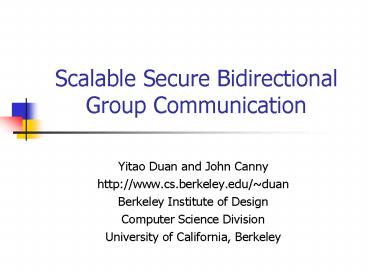Scalable Secure Bidirectional Group Communication - PowerPoint PPT Presentation
1 / 24
Title:
Scalable Secure Bidirectional Group Communication
Description:
So we will focus on confidentiality for multicast and authenticity for aggregation ... Backward Authenticity: a user added at time t should not have the ability to ... – PowerPoint PPT presentation
Number of Views:57
Avg rating:3.0/5.0
Title: Scalable Secure Bidirectional Group Communication
1
Scalable Secure Bidirectional Group Communication
- Yitao Duan and John Canny
- http//www.cs.berkeley.edu/duan
- Berkeley Institute of Design
- Computer Science Division
- University of California, Berkeley
2
Outline
- Secure bidirection group communication
- Model, security definitions, etc.
- The Duan-Canny (DC) multicast encryption
construction - Extension of DC and the new SBGC scheme
- Construction, complexity, security, GDI, etc.
3
Group Communication
n members, up to t lt n may need to be evicted
Center
Members
4
Multicast
Center
Members
5
Aggregation
Center
Members
6
Security Challenges
- Confidentiality and authenticity
- Different challenges for the two modes
- Multicast single sender, authenticity easy
- Aggregation single receiver, confidentiality
easy - So we will focus on confidentiality for multicast
and authenticity for aggregation
7
Security Properties Multicast
- Non-group Confidentiality non-group members
cant access - Forward Confidentiality deleted members cant
have access after deletion - Collusion Freedom no subset of deleted users
should be able to decrypt future group
communication - Backward Confidentiality new members cant
access old data
8
Security Properties Aggregation
- Non-group Authenticity non-group members cant
generate group messages - Forward Authenticity deleted member cant
generate group messages - Collusion Freedom no subset of t or less active
members, nor any subset of deleted members,
should be able to forge messages that the center
accepts as originated from another member not in
the colluding subset - Backward Authenticity a user added at time t
should not have the ability to forge messages
that the center accepts as coming from a member
who was in the group before t .
9
Secure Multicast
- Asymmetric key based schemes
- Traitor tracing CFN94
- Broadcast encryption FN93, BGW05, etc
- Duan-Canny construstion O(1) member key, O(t)
center key, O(t) message - Members dont have to participate in every re-key
operation
- LKHWallner et al., Wong et al.
Keys Assigned to M1
K0
Root Node
K1.1
K1.2
K2.1
K2.2
K2.3
K2.4
Leaf Node
K3.8
K3.1
K3.2
K3.3
K3.4
K3.5
K3.6
K3.7
Member
Use symmetric key crypto O(logn) storage,
message - Members stateful
10
Aggregation Authentication What dont Work Well
- Pair-wise secret between center and each of the
members - Works but not scalable
- Using the traffic encryption key (TEK)
- Global
- Authenticate using PRGN(IDi)
- IDs are public information
- Identity Based Signature
- Complex setting trusted KGC
- Message authentication separate from membership
authentication Center has to store list of
legitimate users. O(n) storage overhead
11
Our Results
- Extended a new multicast enc. to support temporal
security in both multicast and aggregation - Membership authentication is embedded in message
authentication. Aggregation message
authentication also serves as membership
authentication. Center doesnt need keep a list
of legal members - O(t) center storage, O(t) message, O(1) member
storage - The scheme can be made to protect group dynamics
information (GDI)
12
Duan-Canny Construction DC06
x1
(y, x) ? y, x1, , xn, xn1, , xnt
x2
xn1, xn2, , xnt
x3
.
.
.
xn
Center
Members
13
Duan-Canny Construction
Encryption
Decrypting t times using revoked users keys
c Ey(m)
f c, D(xn1, c), D(xn2, c), , D(xnt, c)
Decryption
m ?(D(xi, c), D(xn1, c), D(xn2, c), ,
D(xnt, c))
DC construction preserves or improves the
security of the underlying threshold cryptosystem
(e.g. IND-CCA)
14
Extensions
- Alternating Bit DC (ABDC) to evict more than t
members - In-place update for backward confidentiality
- Novel use of its key structure for authenticating
aggregation messages - Protecting GDI
15
In-place Update
f(?)
x
n
1
2
3
?
16
In-place Update
f(?)
d
x
n
1
2
3
n1
?
17
DC Construction Key Structure
x1
x2
xn1, xn2, , xnt
x3
.
.
.
xn
Center
Members
18
DC Construction Key Structure
x1
x2
xn1, xn2, , xnt, xnt1
x3
.
.
.
xn
Center
Members
19
DC Construction Key Structure
x1
x2
xn1, xn2, , xnt, xnt1
x3
.
.
.
xn
Center
Members
20
Authenticating Aggregation Messages and Group
Membership
21
Protecting Group Dynamics Information (GDI)
- An issue raised by Sun et al 04
- Info about group size, join, departure rate,
etc., leaked by multicast rekey messages a
problem for almost all existing multicast schemes
- Batch rekeying and phantom users to fix dont
really work well
22
Protecting GDI
- Why is it hard?
- Size of rekey message dependent on group size
- Insider can separate rekey messages for member
join from those for member departure - Our scheme
- Message size O(t)
- So we only need to mix join and departure
- Members are given random indexes. Use a mixing
pool to mix join and departure - Center storage becomes O(n) all other schemes
same even w/o protecting GDI
23
Summary
- Defined models and security for bidirectional
group communication - Extended the DC multicast cryptosystem for
backward and authentication security - O(t) center storage, message size, O(1) member
storage - Protecting GDI
24
More Info
- duan_at_cs.berkeley.edu
- http//www.cs.berkeley.edu/duan
- Thank You!































